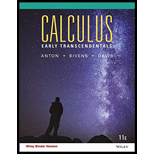
Use the Divergence Theorem to find the flux of F across the surface
Want to see the full answer?
Check out a sample textbook solution
Chapter 15 Solutions
CALCULUS EARLY TRANSCENDENTALS W/ WILE
Additional Math Textbook Solutions
Calculus and Its Applications (11th Edition)
Calculus & Its Applications (14th Edition)
Precalculus Enhanced with Graphing Utilities (7th Edition)
Precalculus: Concepts Through Functions, A Unit Circle Approach to Trigonometry (4th Edition)
Calculus: Early Transcendentals (3rd Edition)
- Helparrow_forwardDetermine the constants a, B, y such that the surfaces ax? z – xy = ß, yæz – y´ = 0, intersect orthogonally at the point (x, y, z) = (-2,2, –1).arrow_forwardLet S be the surface described by the vector function Ř(u, v) = (v², u + v, eu). Find an equation of the plane tangent to S at the point (4, -2, 1).arrow_forward
- 4. Consider the vector function r(z, y) (r, y, r2 +2y"). (a) Re-write this vector function as surface function in the form f(1,y). (b) Describe and draw the shape of the surface function using contour lines and algebraic analysis as needed. Explain the contour shapes in all three orthogonal directions and explain and label all intercepts as needed. (c) Consider the contour of the surface function on the plane z= for this contour in vector form. 0. Write the general equationarrow_forwardIdentify the surface by eliminating the parameters from the vector-valued function r(u,v) = 3 cosv cosui + 3 cosv sinuj + Śsinvk a. plane b. sphere c. paraboloid d. cylinder e. ellipsoid d b a e (Darrow_forwardFind the flow of F=xzi-yk through the upper part of plane z-1 in the x + y +2 = 4sphere.arrow_forward
- Which of the vector functions below represents the curve of intersection of the following two surfaces: x² +4y²+4z² = 16 and y = x². Select one: ○ a. r (t) = (t, t², O b. r (t) = (t, t², |○ c. r (t) = (t, t₁, ○ d. r (t) = t, -t² = (t, 16++²-4+4 4 1 16-12-4t 4 O e. None of the above ○ f. r (t) = (t, t², √ 16-12+4t 4 16-12-4t 4 4-12-4t4 4arrow_forwardAM (2) - Edited Let W be the plane with equation x + 2y + 2z = 1. Define the function f (x,y, z) to be f(x, y, z) = distance from (x, y, z) to W. %3D (a) For each real number k > 0, the level surface f(x, Y, z) = k can be described in terms of other familiar surfaces. Give a geometric description of the level surface f(x, y, z) = k. Be as precise as possible when explaining your answer. %3D (b) For each real number k > 0, produce an explicit equation for the level surface f(r, y, z) = k. (c) Consider the function g = f² (distance square). Find the partial derivatives (r, y, z) and Buể (T, y, z). What do you notice? (d) Let F(t) be a single-variable function. The following table gives some relevant values of this function. F F' F" t = 0 -4 10 t = 1 13 -1 t = 2 -2 9. -3 82h aydz Suppose that h(x, y, z) = F(g(x, Y, z)). Find values of (0,0, 2) and (0, 0, 2) 3:07 7 days ago Dreamland Glass Animals 3:21 Dreamland Glass Animals The Score (Expanded Editi Fugees ADE 7 days ago 3:59 Heat Waves…arrow_forwardLet F(x, y, z) = xzi+yzj + xyk, Surface S is the part of the sphere x² + y² + z² = 4 that lies inside the cylinder x² + y² = 1 and above the xy-plane. Find a vector equation of the boundary curve C. (b) Compute for FdR (c) Compute for C F.Tdsarrow_forward
- Fundamental Theorem Vf• år = f(B) – f(A) of Line Integrals Green's Theorem (8x - f,) dA = f dx + g dy (Circulation form) Stokes' Theorem (V X F) • n dS = Evaluate the line integral for the following problems over the given regions. Use the above theorems if the problem meets the criteria. If the criteria is not met, use Section 17.2 methods for evaluating the line integral.arrow_forwarda) Calculate the directional derivative of the function $(x, y, z) = xy² + yz³ at the point (1,–1,1) in the direction of 3î + ĵ – k. b) Find the direction cosines of the vectors U = 28 + 2ĵ – k and V = 3î – 6j + 2k, and also determine the angle between them. c) Determine the center, vertices and foci of the equation: 4x? – 5y? – 8x – 30y – 21 = 0.arrow_forward
 Calculus: Early TranscendentalsCalculusISBN:9781285741550Author:James StewartPublisher:Cengage Learning
Calculus: Early TranscendentalsCalculusISBN:9781285741550Author:James StewartPublisher:Cengage Learning Thomas' Calculus (14th Edition)CalculusISBN:9780134438986Author:Joel R. Hass, Christopher E. Heil, Maurice D. WeirPublisher:PEARSON
Thomas' Calculus (14th Edition)CalculusISBN:9780134438986Author:Joel R. Hass, Christopher E. Heil, Maurice D. WeirPublisher:PEARSON Calculus: Early Transcendentals (3rd Edition)CalculusISBN:9780134763644Author:William L. Briggs, Lyle Cochran, Bernard Gillett, Eric SchulzPublisher:PEARSON
Calculus: Early Transcendentals (3rd Edition)CalculusISBN:9780134763644Author:William L. Briggs, Lyle Cochran, Bernard Gillett, Eric SchulzPublisher:PEARSON Calculus: Early TranscendentalsCalculusISBN:9781319050740Author:Jon Rogawski, Colin Adams, Robert FranzosaPublisher:W. H. Freeman
Calculus: Early TranscendentalsCalculusISBN:9781319050740Author:Jon Rogawski, Colin Adams, Robert FranzosaPublisher:W. H. Freeman
 Calculus: Early Transcendental FunctionsCalculusISBN:9781337552516Author:Ron Larson, Bruce H. EdwardsPublisher:Cengage Learning
Calculus: Early Transcendental FunctionsCalculusISBN:9781337552516Author:Ron Larson, Bruce H. EdwardsPublisher:Cengage Learning





